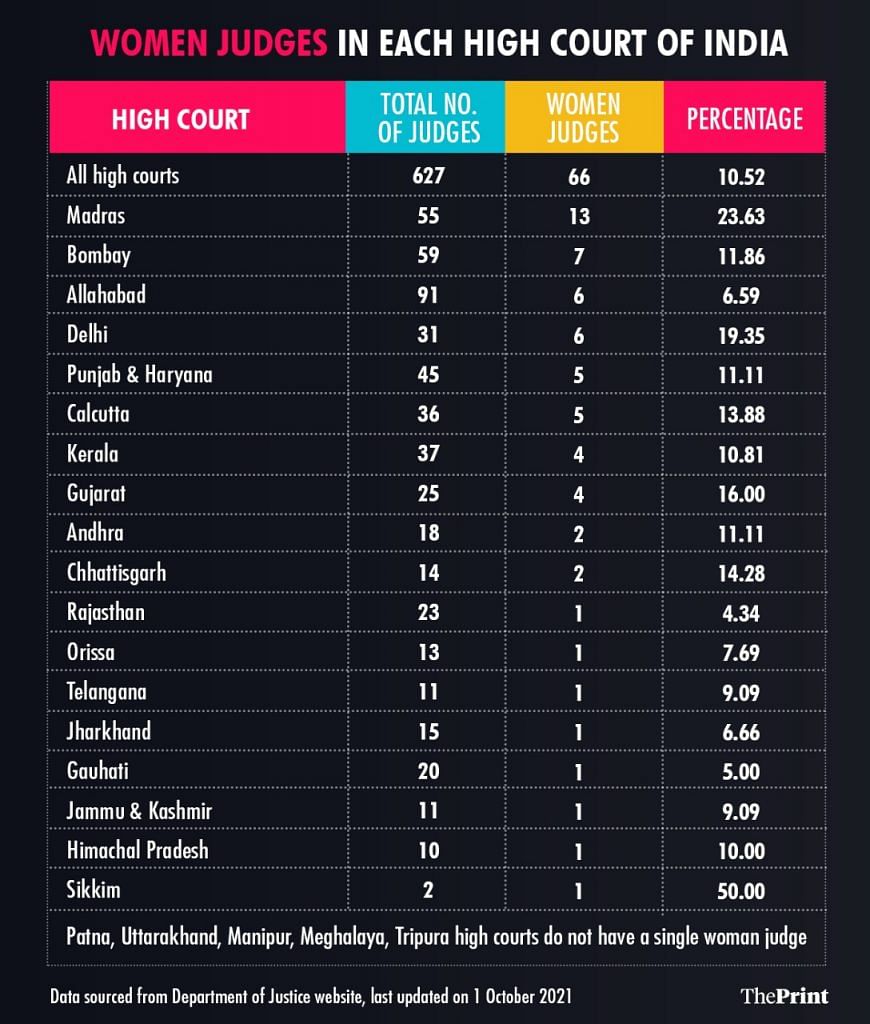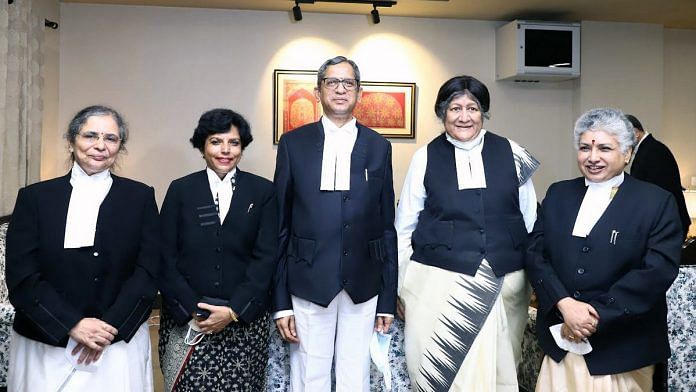New Delhi: Last month, Chief Justice of India N.V. Ramana lamented the miniscule representation of women in the Indian judiciary. The CJI was speaking at an event organised by the Supreme Court Women’s Bar Association to felicitate the nine new judges appointed to the Supreme Court, including three women.
He asserted it was time 50 per cent of seats in the judiciary were reserved for women, as it was their right and not a matter of charity. He shared data to highlight the skewed gender ratio in the judiciary and said there are only 30 per cent women judges in the lower courts and 11.5 per cent in high courts.
Now, four out of the 33 judges in the top court are women, he pointed out, referring to Justices Indira Banerjee, Hima Kohli, B.V. Nagarathna and Bela Trivedi. The latter three judges took oath on 31 August, giving the Supreme Court its highest number of women judges in history.
At the same event, senior advocate Kiran Suri summed up the jubilation of women lawyers in one line — “one, two, three, four, yeh dil maange more” — and urged CJI Ramana to propose the names of more women lawyers as judges to all the 25 HCs.
Justice Nagarathna’s elevation, in particular, is being seen as the proverbial breaking of the glass ceiling, since she is likely to be the first woman Chief Justice of India in 2027, albeit for a short tenure of 40 days. She had also made history in 2008 when she became the first woman lawyer from the Bar to join the Karnataka High Court.
The excitement on display at the 26 September event was not misplaced. Data collated by ThePrint shows there is alarming gender disparity in high courts across the country.
Also read: Justice Nagarathna says appointing women to senior judicial posts can break gender stereotypes
Where each HC stands
Out of 627 judges in all HCs, only 66 are women — just about 10 per cent of the total working strength — according to data from the Department of Justice website that was last updated on 1 October 2021.
The Madras High Court has the maximum number of women judges — 13 out of the working strength of 55. In the past, the Madras HC has had two female chief justices — Indira Banerjee (2017-18) and Vijaya Tahilramani (2018-19).
Here’s how each of the high courts stacks up on this issue:

Statistics from the last 15 years also show that women’s representation in the judiciary has been abysmally low. Between 2006 and 2021, 150 women judges have been appointed to HCs, but 84 of them have already retired, and only 66 are still serving.
Not many women lawyers directly elevated
Another disturbing aspect of gender disparity in the judiciary is that not many women advocates have been elevated to the Bench. There are two types of appointments that take place in HCs — direct elevation from the Bar to the Bench, and promotion of trial court judges.
Of the 150 women picked to be part of the 25 HCs since 2006, only 61 were cases of direct elevation, while the rest were trial court judges who got promoted. Of the current working strength of 66 women judges, 32 are lawyers who were recommended for direct appointment.
In the same 15-year period, the Supreme Court has had nine women judges, including the four currently serving. But only one woman — Justice Indu Malhotra — was a lawyer practicing in the apex court. The other eight were sitting judges of different HCs when their names were recommended.
‘Patriarchal mindset’
According to experts, there are hardly any women in the legal profession, and their low numbers are the reason why there are fewer women judges compared to men.
At the 26 September event, CJI Ramana shared data regarding women lawyers, pointing out that of 17 lakh advocates, only 15 per cent are women. Even elected disciplinary bodies for lawyers, such as the state Bar councils, have only two per cent women members. The apex body of lawyers, Bar Council of India (BCI), has no woman member.
Women lawyers say the struggle for them continues, even though their numbers have gradually increased since the passing of the Legal Practitioners’ (Women) Act in 1923, which allowed them to join the profession.
Advocate Sneha Kalita, who has filed a petition in the SC demanding fair representation of women in courts, said the fact that lower judiciary has around 30 per cent women busts the myth that there is lack of meritorious women candidates.
“When assessment is based on competition, then there is no dearth, and yet women are still fighting to make a better representation in the higher judiciary. What needs to be done away with is the patriarchal mindset and neutral balancing attitude,” Kalita said.
Senior advocate Mahalakshmi Pavani, who has been vocal in her criticism of the non-selection of women lawyers as judges, said those practicing in the top court are worst-affected by the selection process that is heavily tilted towards men. She said women advocates appearing in the SC are never considered for appointment as judges due to strong opposition from the Bar as well as the HC for which they are eligible.
“Women from various states have moved to Delhi for multiple reasons, including their desire to practice in the country’s top court. But the same seems to be working against women. While male lawyers from the SC get appointed, women are never chosen for the same job,” Pavani said.
Gender disparity in the judiciary can also be attributed to absence of women in the collegium of HCs as well as the top court, the panel that selects and recommends names for appointment of judges, and lack of adequate voices in such a forum, Pavani said.
“Barring Justice Ruma Pal, no woman judge has made it to the SC collegium of top three judges that oversees appointments in HCs. Justice Nagarathna will be the second woman judge to achieve that feat,” she added.
(Edited by Shreyas Sharma)
Also read: ‘Only 8 women SC judges in 70 years’: Plea seeks greater representation in higher judiciary



